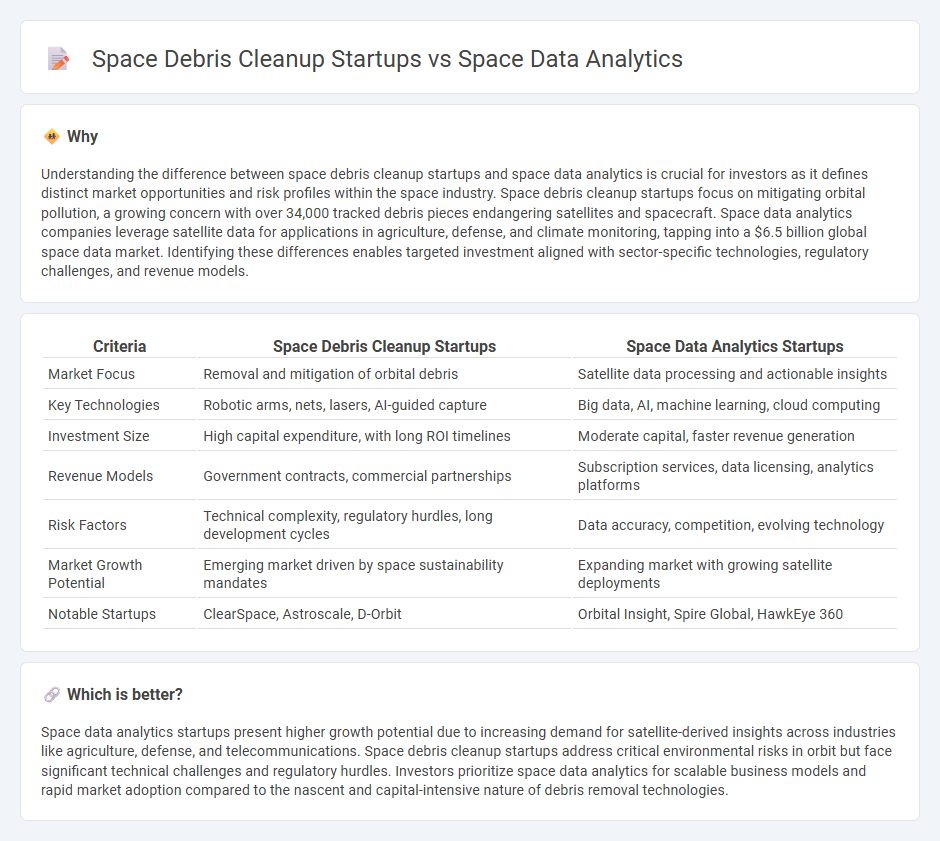
Space debris cleanup startups focus on removing hazardous orbital debris to ensure satellite safety and sustainable space operations, addressing the increasing risks posed by space congestion. Space data analytics companies leverage extensive datasets from satellites and space sensors to provide actionable insights for industries like agriculture, defense, and telecommunications. Discover how these innovative sectors offer diverse investment opportunities in the rapidly evolving space industry.
Why it is important
Understanding the difference between space debris cleanup startups and space data analytics is crucial for investors as it defines distinct market opportunities and risk profiles within the space industry. Space debris cleanup startups focus on mitigating orbital pollution, a growing concern with over 34,000 tracked debris pieces endangering satellites and spacecraft. Space data analytics companies leverage satellite data for applications in agriculture, defense, and climate monitoring, tapping into a $6.5 billion global space data market. Identifying these differences enables targeted investment aligned with sector-specific technologies, regulatory challenges, and revenue models.
Comparison Table
| Criteria | Space Debris Cleanup Startups | Space Data Analytics Startups |
|---|---|---|
| Market Focus | Removal and mitigation of orbital debris | Satellite data processing and actionable insights |
| Key Technologies | Robotic arms, nets, lasers, AI-guided capture | Big data, AI, machine learning, cloud computing |
| Investment Size | High capital expenditure, with long ROI timelines | Moderate capital, faster revenue generation |
| Revenue Models | Government contracts, commercial partnerships | Subscription services, data licensing, analytics platforms |
| Risk Factors | Technical complexity, regulatory hurdles, long development cycles | Data accuracy, competition, evolving technology |
| Market Growth Potential | Emerging market driven by space sustainability mandates | Expanding market with growing satellite deployments |
| Notable Startups | ClearSpace, Astroscale, D-Orbit | Orbital Insight, Spire Global, HawkEye 360 |
Which is better?
Space data analytics startups present higher growth potential due to increasing demand for satellite-derived insights across industries like agriculture, defense, and telecommunications. Space debris cleanup startups address critical environmental risks in orbit but face significant technical challenges and regulatory hurdles. Investors prioritize space data analytics for scalable business models and rapid market adoption compared to the nascent and capital-intensive nature of debris removal technologies.
Connection
Space debris cleanup startups rely heavily on space data analytics to identify, track, and predict the orbits of hazardous debris, enabling targeted removal strategies. Investment in advanced data analytics platforms enhances the precision and efficiency of these cleanup missions, reducing operational risks and costs. The synergy between space debris mitigation and data-driven insights creates compelling opportunities for investors focusing on sustainable space technology.
Key Terms
**Space Data Analytics:**
Space data analytics startups harness advanced satellite imagery, AI algorithms, and big data to extract valuable insights for sectors like agriculture, climate monitoring, and defense. These companies optimize space-derived information to improve decision-making, forecast trends, and automate critical space-based observations. Explore innovative space data analytics solutions shaping the future of Earth observation and commercial space applications.
Geospatial Intelligence
Space data analytics leverages advanced geospatial intelligence to monitor and interpret satellite data, enabling precise mapping and predictive modeling for various space applications. Space debris cleanup startups focus on using geospatial technologies to track and remove hazardous orbital debris, ensuring safer and sustainable space operations. Discover how integrating geospatial intelligence transforms both industries by enhancing spatial awareness and strategic decision-making.
Remote Sensing
Space data analytics leverages remote sensing technologies to monitor and interpret satellite data, enabling real-time analysis of Earth's environmental changes and space situational awareness. Space debris cleanup startups also utilize remote sensing to detect, track, and characterize orbital debris, facilitating targeted removal strategies to reduce collision risks. Explore more about how remote sensing drives innovation in space data analytics and debris mitigation efforts.
Source and External Links
Harnessing Data Analytics in Space Exploration - Space data analytics is critical in modern missions for processing and analyzing sensor data to optimize spacecraft design, navigation, and mission success, exemplified by Chandrayaan-3's precise lunar landing using AI and data science techniques.
What Is Spatial Data Analysis? - USC GIS - Spatial data analysis uses geographic location data from satellites, GPS, and remote sensing to identify spatial patterns and model interactions, turning raw geospatial data into actionable insights applicable in environmental and space contexts.
Space Analytics - Space analytics involves analyzing real-time usage data and existing conditions of physical resources to develop strategic planning and management, including visualization tools that help institutions optimize their space utilization.
 dowidth.com
dowidth.com